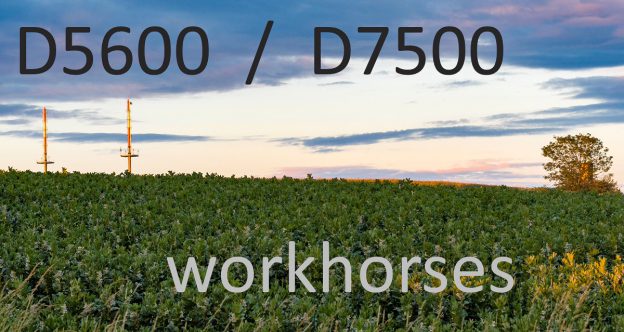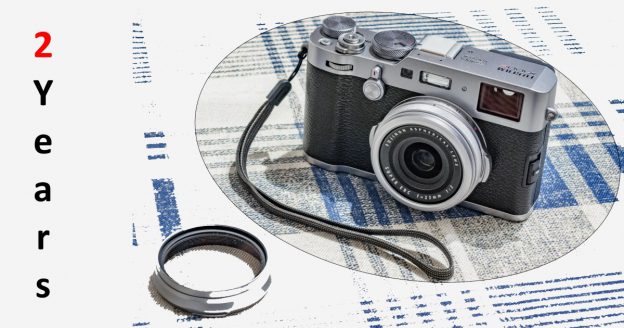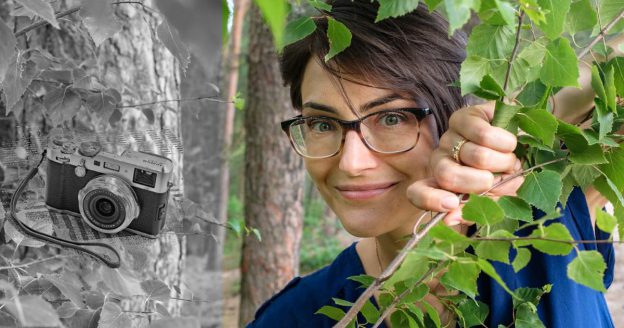Having written glowing reviews about a Fujifilm fixed-lens mirrorless, can there be other cameras? Yes. This is a double-review covering the Nikon D5600 and D7500.
Mature technology
An optical viewfinder, and a flipping mirror in the digital age? I had little interest in seemingly antiquated SLR technology. That changed with D5200 hands-on experience. The camera was well-engineered and just worked.
This convinced me to order the latest model, the D5600. Autofocus speed is fantastic, focus precision reliable. It can be a tiny bit off but still performs well for my practical needs. Metering, white balance, everything works well. The only limitation seems to be the viewfinder autofocus in very low light: Either it does not work at all, or the miss rate is quite high. In only somewhat low, or normal, or bright light, the viewfinder focus is good. For bad light one can switch to live-view autofocus.
Long-time DSRLs users will laugh, but it was a new experience for me: Having the focus both reliable and quick. Being a DSRL beginner I liked the D5600 because it is easy to use. The few limitations I experience remind me how few complaints I have.

Taken in Leipzig on a boat tour
The D5600 never annoys me as much as the X100F which has an autofocus missrate when put against bright light – but the DSLR also does not give those high moments I have with the Fujifilm camera. Instead the 5600 proves to be overall useful and reliable device with no particular up- or downsides for a hobbyist. It does its job. If time is short, I use images out of camera, despite Nikon’s issue with skin tones. The fully articulating screen helps with awkward shooting angles, and can be flipped inside for protection.
The body is compact and light, but it has the same meter, processor, and a similar or the same sensor used in the D7200, which was the DX king not that long ago. The 5600 is an affordable model using proven technology where it matters.
On a couple of occasions I really needed the camera to perform. It did. The 2018 team event photo of the company I am with, does not show me – because I took it.
Close but not quite there
Rational reasons for adding the D7500 include in-door event photography. The true reason is that when testing the camera, I liked it. With that camera I also fulfilled my dream of buying the Nikkor DX 16-80 mm f/2.8-4 ED VR lens.
Other cameras and lenses are surely better, depending on preferences and budget. For me it was like a forbidden dream to consider such expensive camera. And expensive lens.
Weeks, then months of usage, and I still get impressed!

Night shots seem to be quite easy
Camera operation is sometimes more complicated but also feels a bit more professional because of the many dedicated buttons. And then image quality. With high iso settings, the sensor still resolves texture, it still gets somewhat reliable color. Highlight recovery is excellent for a sensor if this size. The D7500 has less sensor pixels, just some 20 instead of the common 24 megapixels, but this proves to be an advantage: Smaller, yet better files.
Using the camera gets me a lot of satisfaction. There are some small issues, like the screen not able to tilt 90° downwards, and some buttons are placed where I don’t want them. I rate the D7500 quite good but not perfect. And compared to the 5600 it is bulky and heavy. This is an issue especially with big lenses attached.
Mirrorless future?
Ever so often one reads the DSLR is supposedly dead. Or will be soon. Or at some point in the future. So another friend switches to mirrorless and proudly shows his/her new camera. But the more time someone takes to read into the latest features, the less I see him/her taking photos. Mirror or not, each system has some peculiarities.
Equipping the D7500 with a prime lens is more fun than expected because the camera offers a 1.3x crop mode, which yields a 12 megapixel image. The effect is the same as cropping in post but it still feels good to have it in-camera. This feature can be used with Raw.
The D5600 works quite well with the 16-80 mm lens because the overall weight is less than a kilogram (just over two pounds). The camera button layout often allows to operate it with only one hand, which is great.

Cliche flower shot, D5600 with DX 16-80 mm lens.
Nikon seemingly designed each camera with care for the intended purpose. The D5600 provides noticeable feedback for a half-pressed shutter button. The D7500 does not have this resistance, which means the user needs a bit more experience to not release prematurely. But taking images quickly is easier this way. Each camera also follows its own button-placement philosophy. And they use different batteries.
For tripod usage I prefer the D7500 with the tilting screen, because an upward facing D5600 screen conflicts with the cable release. The D7500 screen can face down only so much while the D5600 can be fully turned downwards, which sometimes helps when used handheld. The screen aspect ratio for both cameras is different, each having slight advantages in certain situations.
In most situations, the limiting factor is that I am an amateur not yet experienced enough to really exploit any of these cameras. Second limitation is the lens.
Practical concerns like bulk and weight play a role for my walks and bicycle tours, where I sometimes prefer the 5600 with the 18-55 kit lens, or the 35 mm prime. This entry-level equipment feels a bit plasticky but the power-to-weight-ratio is really good. Still a bit porkier than mirrorless systems, but the body provides good grip to hold the camera comfortably.
D7500 details
When I first looked through the viewfinder, I knew I would probably buy this quite expensive camera. The view is larger, brighter, and clearer compared to the D5600. The autofocus pattern is also an upgrade, though the D5600 coverage is already quite good. The D7500 focus is more reliable in low light situations. I rarely ever need those advantages. But do you only buy what you need?
Some D7500 features seemed strange to me at first. The more I use the camera the more I see that they all have their reason, like an AF-point lock switch. If the need for a specific feature comes up, it is usually available, including a multi-axis level. The camera also offers reasonable customizability for the buttons. The new Jpeg picture-control mode “Auto” is useful because the “Standard” mode is too soft for landscape, but too hard for portraits. The Auto mode gets you a fitting tone curve for the scene. As of July 2019, only the D850 and D7500 have this mode.
The D7500 is not a high-end device. The shoulder display can be illuminated but buttons cannot. The camera cannot meter with very old lenses because it has no mechanical aperture reader. It has only one memory card slot. An enthusiastic amateur like me still finds everything needed. Essentially all F-mount lenses which have autofocus can be used in all camera modes, including old film-era models. Even in the dark I find the nicely large buttons. Shutter speed and flash capabilities are state of the art. Continuous shooting offers fast framerates and has a deep buffer. Exposure-bracket options are very flexible. The camera case is made of synthetic material but still feels quite rigid.
D5600 advantages
It is the smaller model, but there are still a couple of upsides to this camera. The screen has more degrees of movement. Most exposure and focus settings can be changed with just three taps on the touchscreen, instead of having to find the dedicated button and keeping it pressed at an uncomfortable position while scrolling through all the options with a wheel. The camera body is very light.
Flash options are limited though, no high-speed synchronization, no commander mode. This positions the 5600 as consumer camera. Other drawbacks like the viewfinder size and brightness were necessary in order to make the camera so lightweight.
Burst framerate and buffer size are good enough for any of my practical needs. Also the general shutter delay, while noticeable when you pay attention, is still something I can work with.
The shutter noise is not as confident as with higher-class cameras, the F-mount bracket not as tight, and the battery door not as sturdy and the body bottom not as rugged, but there is still something to this camera which is difficult to describe. If I grab it and raise it to look through the viewfinder, if I use the touchscreen to move the AF point (a feature the D7500 does not have), if I review an image just taken, it feels good. If if remember the price, it feels really good.
When using which

After getting the D7500 I wanted to confirm that it was a good purchase because the camera can do more than the D5600. With further experience I then noticed anything important for me can be done with the smaller model as well.
For some events I bring both, making two lenses available without having to swap. Alternatively one can be lent in order to get more coverage. The image output is a bit different, this implies additional work on the files to get a consistent gallery. I still prefer this to swap lenses during an event, like photographing a street concert.
I like both cameras, but for different things. The D5600 is very compact and light, most buttons and the mode dial are on on the right side which supports configuration with one hand, and the touchscreen configuration is nice and easy. I don’t miss a front wheel nor any buttons.
The image quality is more determined by the lens than either of these cameras. Cheap kit lenses have to be stopped down quite a bit for good sharpness but considering the sensor’s pixel pitch, the kit lens resolves a lot of detail for little money. The Jpeg output tries to be rather realistic, popping images require further adjustments. The D5600 has many options to edit images in the camera, but there is no batch raw conversion to Jpeg.
The D7500 camera weights more but feels more serious. The case doors feel more solid, too. The camera is not as easy to configure because one has to learn the position of all the buttons. One gets a lot of features which if I am honest almost never need. But when I want a digital level, it is available. The viewfinder is brighter (and larger) and autofocus has more options and better low-light performance.
For almost all of my photography, either camera offers more than I need. Both models make me visible as a photographer, which separates me from the crowd. Getting experience and based on that confidence, that seems much more important to me than contemplating which of the latest camera features one needs.












